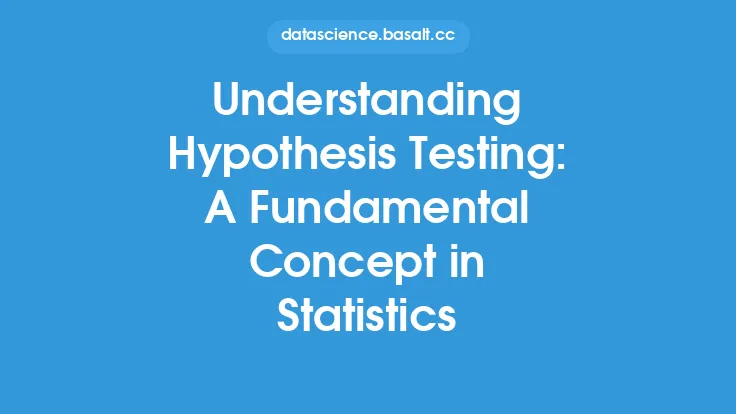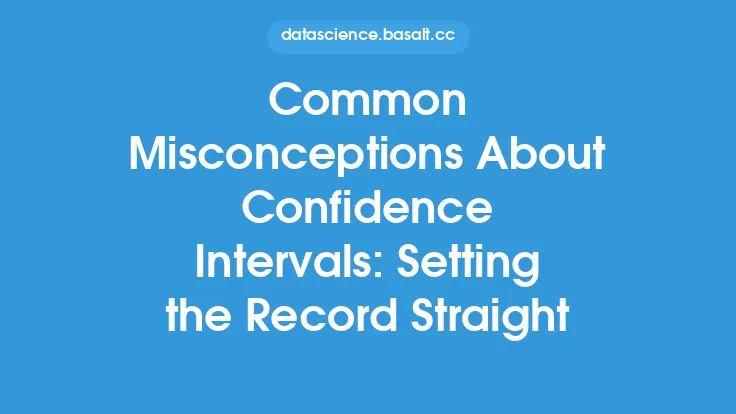Statistics is a branch of mathematics that deals with the collection, analysis, interpretation, presentation, and organization of data. It is a fundamental concept in various fields, including economics, medicine, social sciences, and more. One of the key concepts in statistics is the confidence interval, which provides a range of values within which a population parameter is likely to lie. In this article, we will delve into the concept of confidence intervals, exploring their definition, construction, and interpretation.
Definition and Purpose
A confidence interval is a statistical tool that provides an estimate of a population parameter, such as the mean or proportion, based on a sample of data. It is a range of values within which the true population parameter is likely to lie, with a certain level of confidence. The purpose of a confidence interval is to provide a measure of the uncertainty associated with a statistical estimate, allowing researchers to make informed decisions about the population based on the sample data. Confidence intervals are widely used in statistical analysis, and their construction and interpretation are essential skills for data analysts and researchers.
Construction of Confidence Intervals
The construction of a confidence interval involves several steps, including specifying the population parameter of interest, selecting a sample of data, calculating the sample statistic, and determining the margin of error. The sample statistic is used as an estimate of the population parameter, and the margin of error is a measure of the uncertainty associated with this estimate. The confidence interval is then constructed by adding and subtracting the margin of error from the sample statistic. The width of the confidence interval depends on the sample size, the level of confidence, and the variability of the data. A wider confidence interval indicates greater uncertainty, while a narrower interval indicates greater precision.
Interpretation of Confidence Intervals
The interpretation of a confidence interval is critical in statistical analysis. A confidence interval provides a range of values within which the true population parameter is likely to lie, with a certain level of confidence. For example, a 95% confidence interval for the mean of a population might be (10.2, 12.1), indicating that we are 95% confident that the true population mean lies between 10.2 and 12.1. It is essential to note that the confidence interval does not provide a probability that the true population parameter lies within the interval. Instead, it provides a measure of the uncertainty associated with the estimate, allowing researchers to make informed decisions about the population.
Types of Confidence Intervals
There are several types of confidence intervals, including interval estimates for means, proportions, and regression coefficients. Each type of confidence interval has its own construction and interpretation, and the choice of interval depends on the research question and the type of data. For example, a confidence interval for a mean is used to estimate the population mean, while a confidence interval for a proportion is used to estimate the population proportion. Confidence intervals can also be constructed for regression coefficients, allowing researchers to estimate the relationship between variables.
Assumptions and Limitations
The construction and interpretation of confidence intervals rely on several assumptions, including the assumption of normality, independence, and homoscedasticity. The assumption of normality assumes that the data follow a normal distribution, while the assumption of independence assumes that the observations are independent of each other. The assumption of homoscedasticity assumes that the variance of the data is constant across all levels of the independent variable. If these assumptions are not met, the confidence interval may not provide an accurate estimate of the population parameter. Additionally, confidence intervals have several limitations, including the fact that they do not provide a probability that the true population parameter lies within the interval, and they do not account for non-sampling errors, such as measurement error.
Conclusion
In conclusion, confidence intervals are a fundamental concept in statistics, providing a range of values within which a population parameter is likely to lie, with a certain level of confidence. The construction and interpretation of confidence intervals are essential skills for data analysts and researchers, and their application is widespread in various fields. While confidence intervals have several assumptions and limitations, they provide a valuable tool for estimating population parameters and making informed decisions about the population based on sample data. By understanding the concept of confidence intervals, researchers can improve their statistical analysis and provide more accurate estimates of population parameters.





